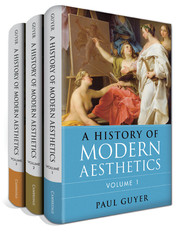Book contents
- Volume 1 The Eighteenth Century
- Volume 2 The Nineteenth Century
- Frontmatter
- Contents
- Acknowledgments
- Introduction
- Part One German Aesthetics in the First Half of the Nineteenth Century
- Part Two (Mostly) British Aesthetics in the Second Half of the Nineteenth Century
- Part Three German Aesthetics in the Second Half of the Nineteenth Century
- Bibliography
- Index
- Volume 3 The Twentieth Century
Introduction
from Volume 2 - The Nineteenth Century
Published online by Cambridge University Press: 05 June 2015
- Volume 1 The Eighteenth Century
- Volume 2 The Nineteenth Century
- Frontmatter
- Contents
- Acknowledgments
- Introduction
- Part One German Aesthetics in the First Half of the Nineteenth Century
- Part Two (Mostly) British Aesthetics in the Second Half of the Nineteenth Century
- Part Three German Aesthetics in the Second Half of the Nineteenth Century
- Bibliography
- Index
- Volume 3 The Twentieth Century
Summary
Periodization is always one of the great challenges for historiography. Deciding how to define the nineteenth century in the history of aesthetics is no exception. For some purposes, such as political and diplomatic history, a “long nineteenth century,” running from 1789 to 1914, that is, from the French Revolution to the outbreak of World War I, might make sense, although if the Revolution is considered well within the eighteenth century and the Napoleonic era considered a continuation of that era, then the nineteenth century might only run from 1815 to 1914, which is in any case exactly one hundred years. In aesthetics, there are many if not more possibilities, due to different developments in different national traditions or even within single national traditions. Thus, in the case of Britain, the eighteenth-century flourishing of the field was largely completed with Thomas Reid’s Essays on the Intellectual Powers of Man of 1785 and Archibald Alison’s Essays on the Nature and Principles of Taste of 1790, but it made sense to include Dugald Stewart in the eighteenth century, even though some of his relevant work was published only as late as 1810, because of his proximity to the intellectual world of those authors. In Germany, the situation is even more complicated. It would be perfectly natural to think of Kant’s Critique of the Power of Judgment of 1790 as the culmination of the developments that began in Germany with Wolff and of the developments that began in Britain with Hutcheson and Hume, as well as conceiving of it as a conclusive rejection of a tradition that began in France with Du Bos, and then to think of everything coming after Kant as part of a new epoch. Thus, in German aesthetics, the nineteenth century might begin after 1790. But we have already treated several prominent authors whose main works in aesthetics were published later in the 1790s, or even the first decade of the 1800s, namely Schiller, Goethe, von Humboldt, and even Herbart, in the last chapter of the previous book, because of their intellectual proximity to Kant; and Herder’s Kalligone, published in 1800, which some might regard as the last year of the eighteenth century and others as the first year of the nineteenth century, certainly had to be treated there because it is so explicitly a critique of Kant.
- Type
- Chapter
- Information
- A History of Modern Aesthetics , pp. 1 - 8Publisher: Cambridge University PressPrint publication year: 2014



